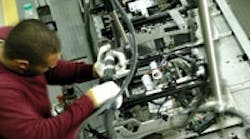Like most companies in the U.S. automotive industry, Lear Corp. finds itself in a fight for survival. The $17.8 billion automotive seating systems manufacturer is battling back from previous-year losses, posting a third-quarter profit of $41 million after a $74 million loss during the year-earlier period.
The Southfield, Mich.-based 2007 IW US 500 Manufacturer aims to build on its progress with a restructuring initiative that includes sourcing to low-cost countries, capacity alignment and administrative consolidation, according to company statements. Part of its continuous improvement process also includes the adoption of lean manufacturing.
The company publicized some results of its lean initiative, which it refers to as the Lear Manufacturing System (LMS), after the Automotive Manufacturing Solutions Global Conference in Dearborn, Mich., in early October. Lear has focused on four key areas of improvement -- housekeeping, quality, plant layouts and material flow.
The company already has realized results at several facilities. Lear employees working at one supplier base increased productivity by 33% and reduced floor space by 18% by realigning work stations, adopting one-piece flow and reducing non-value-added work, according to Tony Coomer, the company's vice president of advanced manufacturing and continuous improvement, seating systems. The company made the changes to facilitate lean product design, which Coomer says is critical because approximately two-thirds of product design costs are tied to the initial design stage.
By doing so, Lear has adopted a strategy that is fairly common with plants seeking process improvements. Indeed, value-stream mapping was identified by 45.5% of 424 firms responding to the 2007 IW/MPI Census of U.S. Manufacturers as one of their strategic processes.
The Monclova plant also introduced a live electronic pull system to reduce waste created from overproduction, work-in-process, changeovers and material movement. Even something as simple as switching from disposable to reusable containers resulted in a first-year package cost reduction of nearly 40%.
These lean accomplishments were driven by employees who attend a three-week training workshop, notes Coomer. "Our training program is designed to develop synergy between plants, empower people to make changes, and create value for customers and shareholders," he says. "It has enabled us to establish a common and consistent lean manufacturing strategy throughout the company."
See Also



